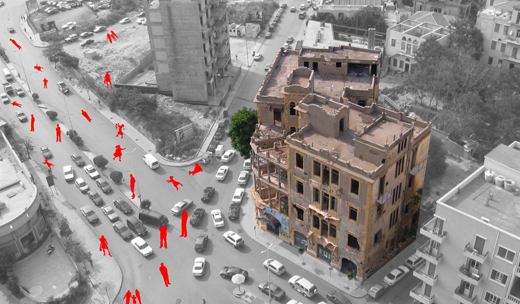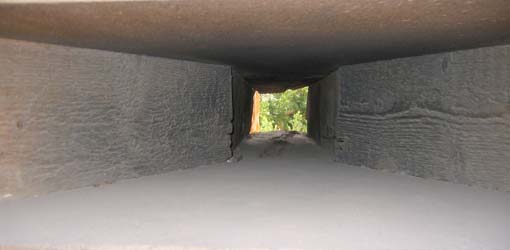Framing Barakat
Posted on December 15, 2011 | posted by: They had the same name. No one knew who inherited it first. One was a building, the other was a man, and they were both called Barakat. They met back in 1975 under unusual circumstances. Barakat-the-man found a refuge in Barakat-the-building and decided to hold the fort till 1990.
They had the same name. No one knew who inherited it first. One was a building, the other was a man, and they were both called Barakat. They met back in 1975 under unusual circumstances. Barakat-the-man found a refuge in Barakat-the-building and decided to hold the fort till 1990.
Barakat-the-man was 19 years old when the Lebanese civil war began in 1975; he was also a young activist in a Christian political party. The young man was still enrolled in Saint Joseph University’s Beirut Campus in the civil engineering program when he was drafted to participate in the combat. He first went through a military training boot camp where his impressive shooting talents were quickly noticed. He was then, accordingly, assigned his first position as a militiaman; he was to become a sniper. He moved into Barakat-the-building by the end of 1975 and as time passed by the man and the building became more and more dependent on one another.
You see, Barakat-the-building was strategically positioned; her principal building was parallel to the demarcation line that separated west Beirut from east Beirut. Her main façade, located on the east side, had a breathtaking view of the western enemy’s territory. One of the main west windows in the first floor happened to be carefully hidden behind a large voluptuous pine tree; from there you could see without being seen. The building also comprised another block that expanded to the east separated from the main frontal unit by an indoor patio, offering in its second wing a safe refuge away from the trenches.
Barakat-the-man quickly spotted all the benefits his new shelter offered him and as the years passed by he carefully engineered his daily routine around it. First, he built his bunker in the first floor, with judiciously designed peepholes directed in the axis of the western window in the shadow of the pine tree. From that bunker, every day for 15 years, he shot at the enemy. During the night he would discreetly escape to the east isle and sleep in the deepest basement, his pillow pointed towards the east, where fellow Christian friends were.
A couple of years into the war, Barakat-the-man had perfected his game; his shots had become infallible, he soon became the most renowned and skilled sniper. Everyone on the west dreaded him. Hidden behind the pine tree he was unreachable yet he had the best aim towards the western territory. Around Barakat-the-building, the sniper traced an invisible circle, radiating from the first floor window, transformed by his expertise into a no man’s land. Barakat-the-man was now known as Barakat-the-sniper.
The real ingenuity of Barakat-the-sniper mainly relies on his mastery of two main skills: system thinking –inherited by his short yet fruitful training as an engineer- and framing –in both the literal and metaphorical senses of the word.
Indeed, the young man had crafted a foolproof system in his daily routine: shoot at west, sleep at east; where the reinforcing feedback loop was “kill more people” and the balancing loop was “do not get killed”. The reinforcing loop was the drive that helped him wake up every morning for almost 15 years and climb his way up from east to west. And the balancing loop kept him from venturing around and led him straight back to his bunker safely niched behind the pine tree. It also forced him to perfect his installation, as the years passed by, he added a few layers to his shell: at first the bunker was only built with bricks and the peepholes were just cut into the walls, then multiple layers of sandbags where added to bulletproof the thin walls. To maintain the accuracy of the peepholes and keep the sandbags apart, wooden frames in the shape of funnels were built allowing better shooting aim. Finally when the construction became too heavy for Barakat-the-building to carry, the crafty engineer added some bearing structures underneath his nest to redistribute some of the load.
On another hand, Barakat-the-sniper was a master of framing; after all he designed the ideal frame for killing. In fact, the funnel shaped peephole he built into the thick walls of his bunker was everything he needed to complete his mission: the wide shape on his end gave him enough room for maneuver yet was narrow enough at the end to keep him focused on the target. During his 15 years in the bunker, all Barakat-the-sniper could see was framed through that hand crafted wooden channel. He had of course invented the ideal artifact to keep a militiaman’s sight in one direction but he had also prototyped a physical representation of the war itself; a narrow-minded conflict that imprisoned the “other” at the end of the funnel. Barakat-the-sniper’s peephole is indeed the frame everyone used to view the enemy. It was also the framework they used to act and react.
In 1990, when discussions around signing a peace treaty were finally introduced, the story goes that one of the main conditions imposed by the western side leaders was to kill Barakat-the-sniper. He had transformed into the last obstacle standing in the way to peace. In order for that condition to be fulfilled there was only one peephole that anyone could think of to infiltrate the system: being on the other side of the funnel. During that last night that witnessed both Barakat-the-sniper and Barakat-the-building united, shots were intensified from the west towards the pine tree. Around midnight, as Barakat-the-sniper was busy shooting through his peephole, a militiaman from the west was given access for a few minutes in order to infiltrate the building from the east side. That night a man from the west was in the east, inside the bunker, on the wider side of the cone, with a knife in his hand. Ironically, the militiaman, that succeeded that night in his mission, was the only one to have ever used the frame in the right way.
Years later, the story of the deadly sniper is still framed through the same peephole, a minor iteration has been implemented: both the building and the sniper are now referenced as Barakat.
